Abstract
Skin electrodes are the most convenient reference electrodes for clinical measurements of electrical potential differences (pd) across the epithelium of the alimentary tract but the presence of an electrical charge on normal skin introduces an error. In the present study, by comparison with results obtained using subcutaneous and intravenous electrodes, it was shown that an intradermal injection of saline abolished the skin potential differences. This simple method, therefore, allows skin electrodes to be used to measure the true transepithelial potential differences of gut mucosa. The method was applied to investigate the effect on the rectal potential difference of altering the composition of the luminal solutions. Changes in the cations (sodium, potassium, magnesium) showed that sodium was the most important cationic determinant of the potential difference, especially when sodium absorption was stimulated by giving mineralocorticoids. Changes in the anions (chloride, iodide, bromide, nitrate, bicarbonate, sulphate, phosphate, citrate, and acetate) indicated that the molecular size of the anion rather than its chemical nature was the significant factor and suggested that the ions had to cross a barrier relatively impermeable to anions of radius greater than 3·5 to 4 A°. Changes in osmolality and glucose concentration were without effect.
Full text
PDF
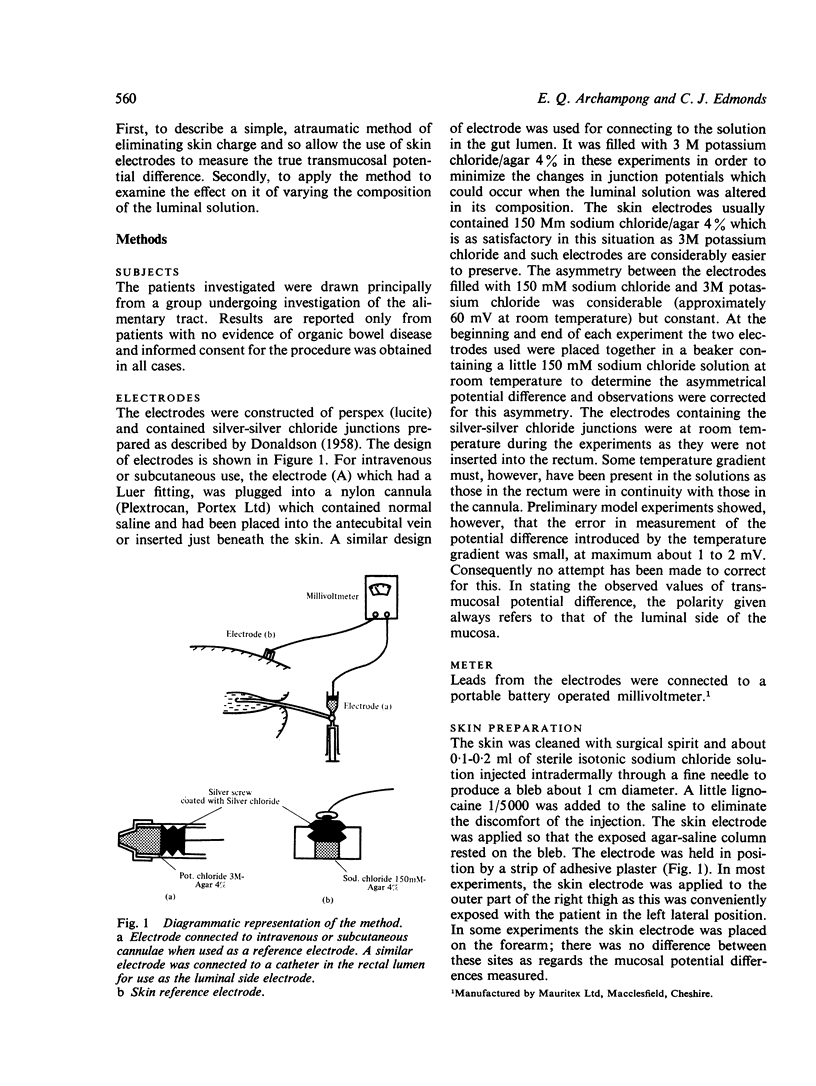
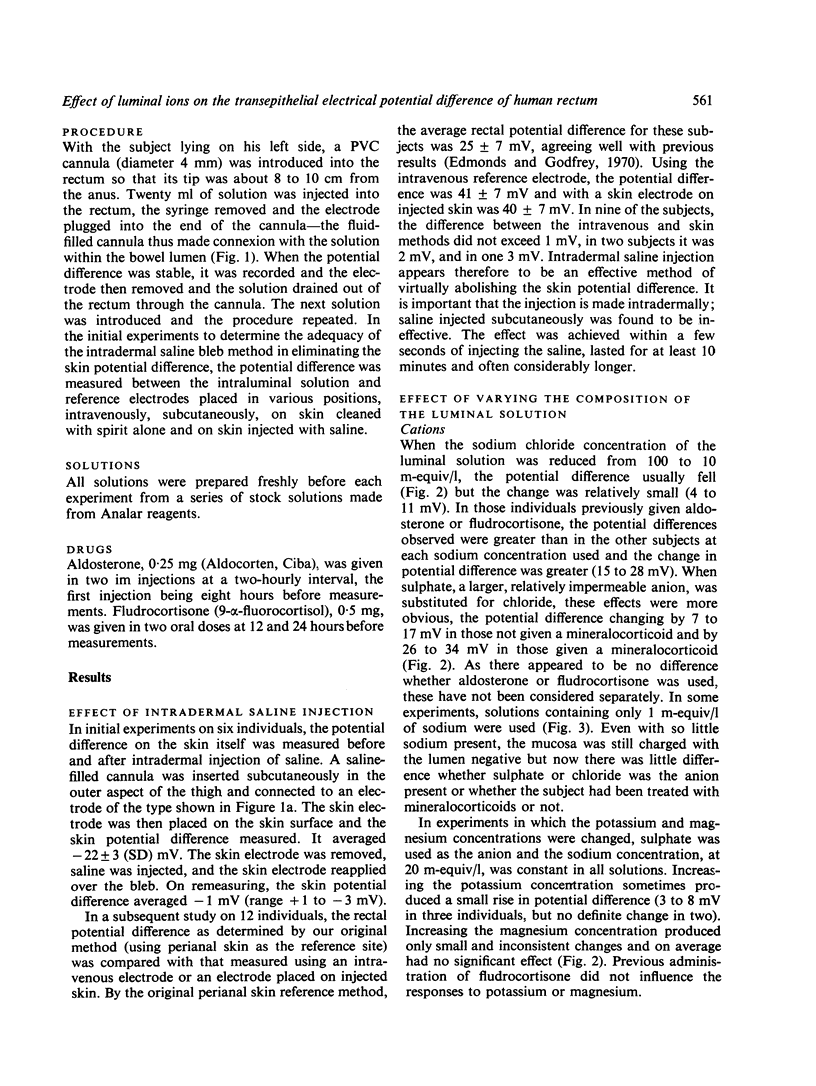
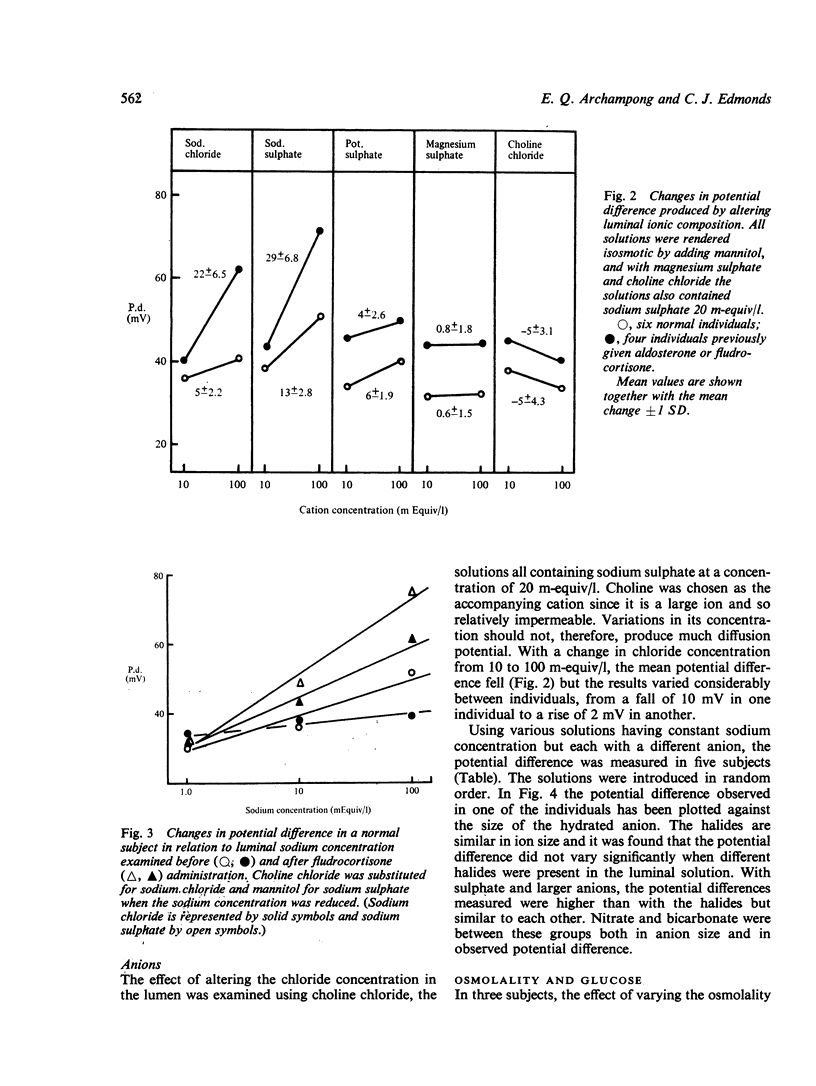
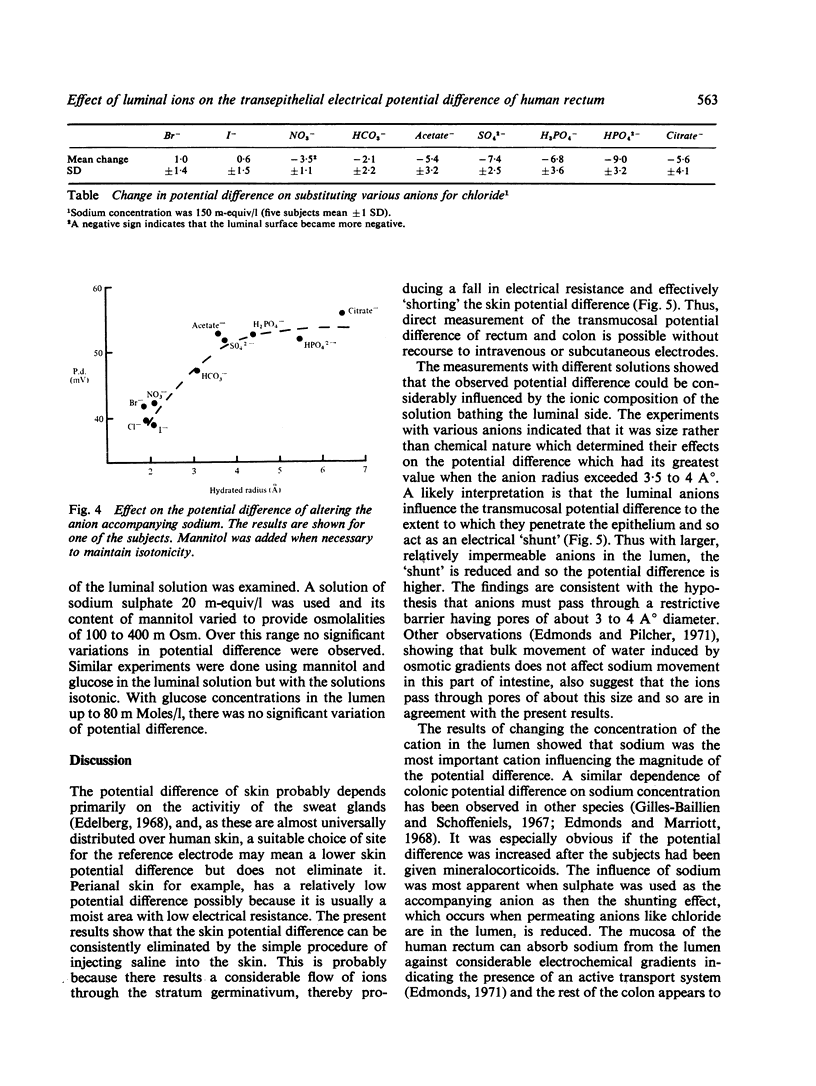
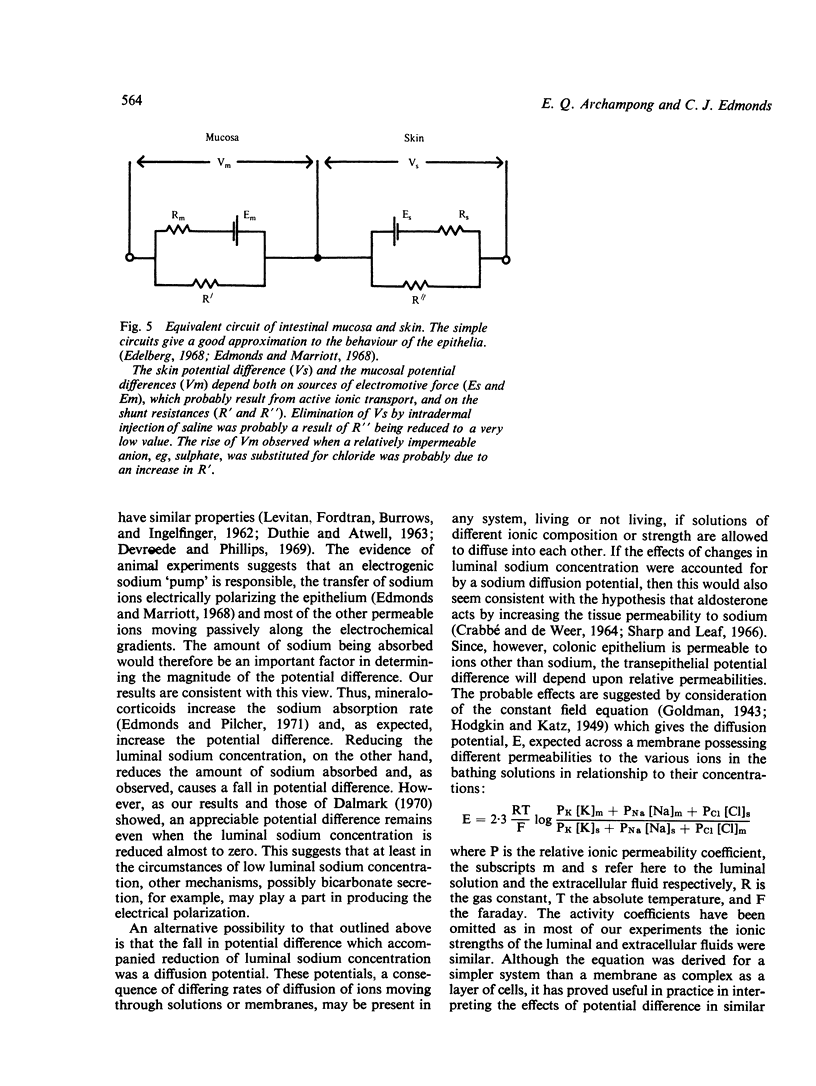
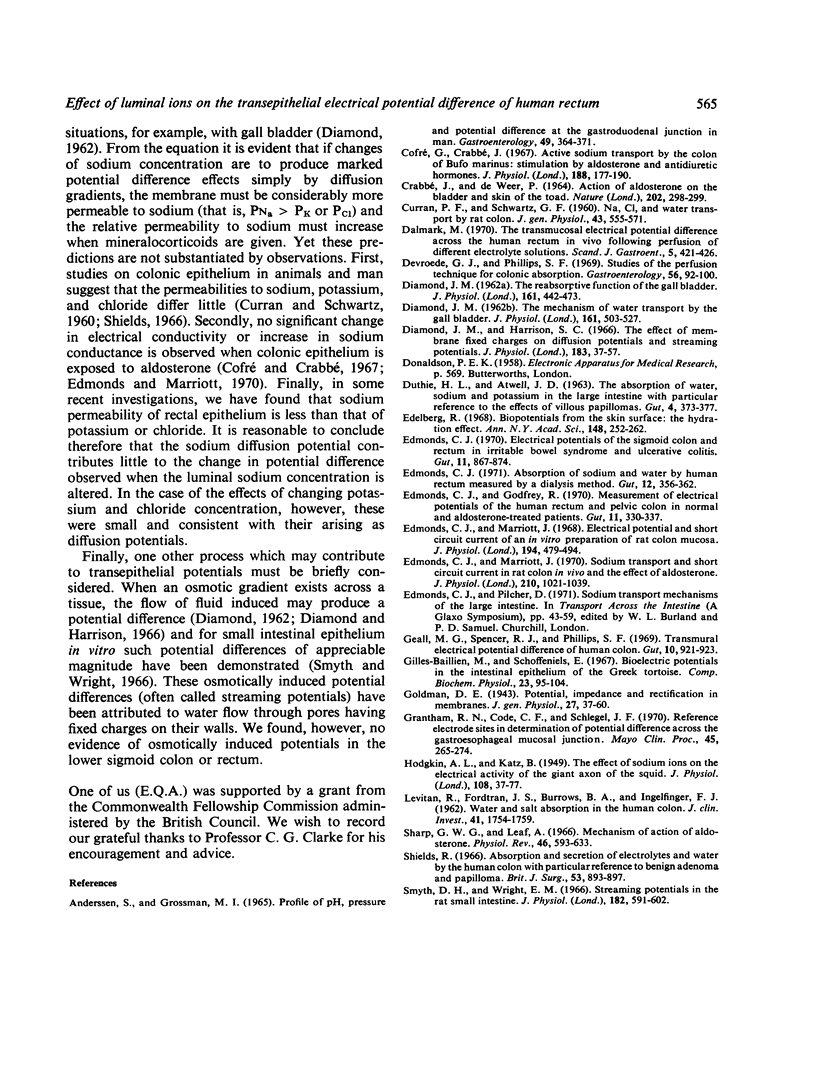
Selected References
These references are in PubMed. This may not be the complete list of references from this article.
- Andersson S., Grossman M. I. Profile of pH, pressure, and potential difference at gastroduodenal junction in man. Gastroenterology. 1965 Oct;49(4):364–371. [PubMed] [Google Scholar]
- CURRAN P. F., SCHWARTZ G. F. Na, Cl, and water transport by rat colon. J Gen Physiol. 1960 Jan;43:555–571. doi: 10.1085/jgp.43.3.555. [DOI] [PMC free article] [PubMed] [Google Scholar]
- Cofré G., Crabbé J. Active sodium transport by the colon of Bufo marinus: stimulation by aldosterone and antidiuretic hormone. J Physiol. 1967 Jan;188(2):177–190. doi: 10.1113/jphysiol.1967.sp008132. [DOI] [PMC free article] [PubMed] [Google Scholar]
- DIAMOND J. M. The mechanism of water transport by the gall-bladder. J Physiol. 1962 May;161:503–527. doi: 10.1113/jphysiol.1962.sp006900. [DOI] [PMC free article] [PubMed] [Google Scholar]
- DUTHIE H. L., ATWELL J. D. THE ABSORPTION OF WATER, SODIUM, AND POTASSIUM IN THE LARGE INTESTINE WITH PARTICULAR REFERENCE TO THE EFFECTS OF VILLOUS PAPILLOMAS. Gut. 1963 Dec;4:373–377. doi: 10.1136/gut.4.4.373. [DOI] [PMC free article] [PubMed] [Google Scholar]
- Dalmark M. The transmucosal electrical potential difference across the human rectum in vivo following perfusion of different electrolyte solutions. Scand J Gastroenterol. 1970;5(5):421–426. [PubMed] [Google Scholar]
- Devroede G. J., Phillips S. F. Studies of the perfusion technique for colonic absorption. Gastroenterology. 1969 Jan;56(1):92–100. [PubMed] [Google Scholar]
- Diamond J. M., Harrison S. C. The effect of membrane fixed charges on diffusion potentials and streaming potentials. J Physiol. 1966 Mar;183(1):37–57. doi: 10.1113/jphysiol.1966.sp007850. [DOI] [PMC free article] [PubMed] [Google Scholar]
- Edelberg R. Biopotentials from the skin surface: the hydration effect. Ann N Y Acad Sci. 1968 Feb 1;148(1):252–262. doi: 10.1111/j.1749-6632.1968.tb20353.x. [DOI] [PubMed] [Google Scholar]
- Edmonds C. J. Absorption of sodium and water by human rectum measured by a dialysis method. Gut. 1971 May;12(5):356–362. doi: 10.1136/gut.12.5.356. [DOI] [PMC free article] [PubMed] [Google Scholar]
- Edmonds C. J. Electrical potentials of the sigmoid colon and rectum in irritable bowel syndrome and ulcerative colitis. Gut. 1970 Oct;11(10):867–874. doi: 10.1136/gut.11.10.867. [DOI] [PMC free article] [PubMed] [Google Scholar]
- Edmonds C. J., Godfrey R. C. Measurement of electrical potentials of the human rectum and pelvic colon in normal and aldosterone-treated patients. Gut. 1970 Apr;11(4):330–337. doi: 10.1136/gut.11.4.330. [DOI] [PMC free article] [PubMed] [Google Scholar]
- Edmonds C. J., Marriott J. Electrical potential and short circuit current of an in vitro preparation of rat colon mucosa. J Physiol. 1968 Feb;194(2):479–494. doi: 10.1113/jphysiol.1968.sp008419. [DOI] [PMC free article] [PubMed] [Google Scholar]
- Edmonds C. J., Marriott J. Sodium transport and short-circuit current in rat colon in vivo and the effect of aldosterone. J Physiol. 1970 Nov;210(4):1021–1039. doi: 10.1113/jphysiol.1970.sp009255. [DOI] [PMC free article] [PubMed] [Google Scholar]
- Geall M. G., Spencer R. J., Phillips S. F. Transmural electrical potential difference of the human colon. Gut. 1969 Nov;10(11):921–923. doi: 10.1136/gut.10.11.921. [DOI] [PMC free article] [PubMed] [Google Scholar]
- Gilles-Baillien M., Schoffeniels E. Bioelectric potentials in the intestinal epithelium of the Greek tortoise. Comp Biochem Physiol. 1967 Oct;23(1):95–104. doi: 10.1016/0010-406x(67)90476-8. [DOI] [PubMed] [Google Scholar]
- Grantham R. N., Code C. F., Schlegel J. F. Reference electrode sites in determination of potential difference across the gastroesophageal mucosal junction. Mayo Clin Proc. 1970 Apr;45(4):265–274. [PubMed] [Google Scholar]
- HODGKIN A. L., KATZ B. The effect of sodium ions on the electrical activity of giant axon of the squid. J Physiol. 1949 Mar 1;108(1):37–77. doi: 10.1113/jphysiol.1949.sp004310. [DOI] [PMC free article] [PubMed] [Google Scholar]
- LEVITAN R., FORDTRAN J. S., BURROWS B. A., INGELFINGER F. J. Water and salt absorption in the human colon. J Clin Invest. 1962 Sep;41:1754–1759. doi: 10.1172/JCI104634. [DOI] [PMC free article] [PubMed] [Google Scholar]
- Sharp G. W., Leaf A. Mechanism of action of aldosterone. Physiol Rev. 1966 Oct;46(4):593–633. doi: 10.1152/physrev.1966.46.4.593. [DOI] [PubMed] [Google Scholar]
- Shields R. Absorption and secretion of electrolytes and water by the human colon, with particular reference to benign adenoma and papilloma. Br J Surg. 1966 Oct;53(10):893–897. doi: 10.1002/bjs.1800531019. [DOI] [PubMed] [Google Scholar]
- Smyth D. H., Wright E. M. Streaming potentials in the rat small intestine. J Physiol. 1966 Feb;182(3):591–602. doi: 10.1113/jphysiol.1966.sp007839. [DOI] [PMC free article] [PubMed] [Google Scholar]


